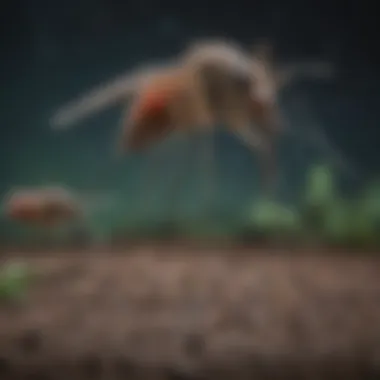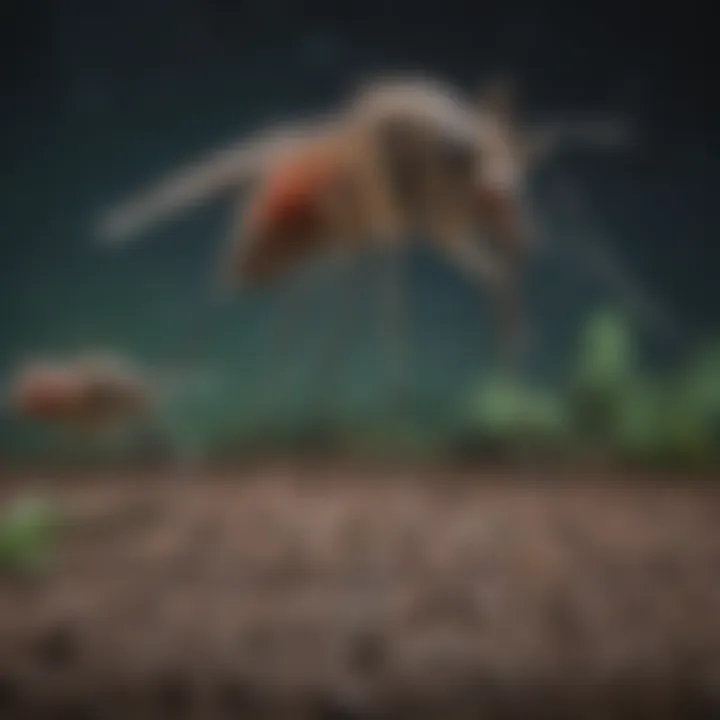Exploring Mosquito Diversity and Health Impacts in Texas


Intro
Mosquitoes are often dismissed as mere nuisances, but their significance in Texas extends far beyond itchy bites. The state is home to a diverse array of mosquito species, each contributing uniquely to the local ecosystem and impacting public health. This article serves as a detailed exploration of the various types of mosquitoes found in Texas, focusing on their ecological roles, breeding patterns, and associated health implications.
Understanding these elements is crucial for several reasons. First and foremost, mosquitoes are vectors for numerous diseases, including West Nile virus, Zika virus, and dengue fever. The influence of these vectors on the health of populations cannot be underestimated. Additionally, mosquitoes play a complex role in the food web, impacting both wildlife and vegetation. By gaining insight into the diverse species present in Texas, this article aims to provide readers with essential knowledge that can inform public health strategies, environmental management, and scientific research in the region.
Intro to Mosquito Species in Texas
Understanding the various mosquito species in Texas is essential for numerous reasons. Mosquitoes are not just a nuisance; they carry the potential for serious public health risks. As vectors for numerous diseases, including West Nile virus and Zika virus, their presence in Texas necessitates careful examination. This section focuses on key aspects that influence the dynamics of mosquito populations in the region.
Texas is home to a diverse array of ecological environments, ranging from coastal areas to dense forests and urban centers. This variety creates ideal breeding grounds for multiple mosquito species. Studying these species helps us understand their behaviors, distributions, and their adaptations to the local environment. Such knowledge is vital for effective public health strategies and for controlling mosquito populations.
Moreover, with climate variability and urban expansion, there is an increasing need to monitor mosquito populations and their habitats. Temperature changes can directly affect mosquito breeding cycles, while urbanization can create standing water, which is a breeding ground for these insects. Knowledge gathered here will provide important insight into managing mosquito-related public health issues.
The exploration into mosquito species in Texas encompasses several elements. First, recognizing the types of mosquitoes prevalent in the area is crucial. Certain species have unique dietary habits, breeding preferences, and behaviors that influence their interactions with humans. Second, the understanding of mosquito life cycles and ecological roles is significant. Mosquitoes play a role beyond being disease vectors; they are also integral to the local ecosystem.
In summary, the forthcoming sections will delve deeper into the specifics of mosquito species in Texas, addressing their ecological roles and public health implications. With this valuable information, we shall be better equipped to tackle the issues posed by these insects, enhancing both our understanding and management approaches.
Overview of Texas as a Habitat for Mosquitoes
Understanding Texas as a habitat for mosquitoes is essential. The state's unique geographical features and varied climate contribute significantly to the presence and diversity of mosquito species. With diverse ecosystems, Texas provides an ideal environment for these insects to thrive.
The numerous habitats in Texas range from wetlands and rivers to urban areas and forests. These locations offer ample breeding sites, ensuring that mosquito populations remain robust throughout different seasons.
In addition to geographical diversity, the climate conditions in Texas play a crucial role in shaping mosquito behavior. Warm temperatures and adequate rainfall create a favorable environment for mosquito reproduction. Awareness of these factors helps in understanding how mosquitoes operate in this region.
Several considerations come into play when examining mosquitoes in Texas. For instance, their role as vectors for diseases such as West Nile virus and Zika virus highlights the importance of monitoring mosquito populations.
Additionally, public health initiatives must respond to rising populations. This underscores the need for effective control measures to protect communities from potential health risks. Studying mosquitoes in Texas allows researchers to develop targeted strategies for population management and disease prevention.
Overall, the intricate interplay between Texas's environment and mosquito species makes this topic essential for ecological and public health discussions. By exploring the characteristics that support these populations, we can gain valuable insights into their ecological impact and the health concerns they pose.
Geographical Features and Climate Conditions
Texas is the second largest state in the United States, exhibiting a multitude of geographical features. Ranging from coastal areas on the Gulf of Mexico to mountainous regions in the west, these diverse landscapes contribute to varying mosquito populations. The presence of large bodies of water, like lakes and rivers, along with marshy areas, provides crucial breeding ground for mosquitoes.
The climate in Texas varies dramatically across the region. The eastern part experiences humid subtropical temperatures, while the western area leans toward a semi-arid climate. Warm summers promote mosquito activity, moving them to breed more frequently. Rainfall is a significant factor, as it creates temporary pools where mosquitoes can lay eggs.
In summary, geographical and climatic factors unite to make Texas a prime habitat for mosquitoes.
Seasonal Variations Affecting Mosquito Populations
Seasons in Texas have a strong influence on mosquito populations. In spring, the warming temperatures and increased rainfall create optimal conditions for breeding. Mosquitoes emerge from their dormant states, leading to higher populations as they search for hosts.
Summer provides consistently warm temperatures, which allow mosquitoes to continue thriving. This period often sees increased mosquito activity. As summer transitions into fall, however, mosquito populations may decrease due to cooler temperatures and reduced humidity. After the first frost of the winter, many species enter hibernation.
Persistent communication about these seasonal changes is critical for effective mosquito control. Public health programs benefit from understanding the seasonal trends that influence populations.
Key Types of Mosquitoes in Texas
Understanding the diversity of mosquito species is crucial for several reasons. First, different types of mosquitoes have distinct behaviors, habitats, and breeding patterns. This knowledge helps in implementing effective control measures, especially since certain species are responsible for transmitting diseases. Furthermore, identifying species can provide insights into the ecological dynamics of Texas, including how these insects interact with the environment and their role in local ecosystems.
Aedes Mosquitoes
Aedes mosquitoes are a significant concern in Texas due to their role in transmitting diseases such as Zika virus, dengue, and chikungunya. One of the most well-known species in this group is Aedes aegypti. This mosquito prefers urban settings and breeds in artificial containers, making it common in residential areas. Its adaptability to urban environments contributes to its rapid population growth. The bite of Aedes mosquitoes is usually more aggressive during the daytime, which is another factor contributing to their effectiveness as disease vectors.
Some noteworthy characteristics of Aedes mosquitoes include:
- Habitat: Found in areas with standing water, such as flower pots, buckets, and discarded tires.
- Behavior: They exhibit aggressive feeding patterns, particularly in the early morning and late afternoon.
- Reproductive Traits: Females can lay up to 300 eggs at a time, increasing the likelihood of high population densities.


Culex Mosquitoes
Culex mosquitoes are another prevalent group in Texas. Among them, Culex quinquefasciatus, often known as the southern house mosquito, is distinctively notable. These mosquitoes are primarily nocturnal and are recognized as vectors for diseases like West Nile virus and St. Louis encephalitis. Unlike Aedes mosquitoes, Culex prefers to breed in stagnant water bodies, including dirty water and poorly maintained pools.
Their characteristics include:
- Habitat: Culex species thrive in polluted water sources and urban landscapes.
- Behavior: They tend to feed late at night, which can make them less noticeable compared to daytime feeders.
- Life Cycle: Culex mosquitoes can adapt to varied environments, allowing them to exploit available water sources efficiently.
Anopheles Mosquitoes
Anopheles mosquitoes, though less common in urban areas, have an important role in Texas, particularly regarding malaria transmission. Anopheles quadrimaculatus is the primary species in the region. These mosquitoes tend to breed in clean, freshwater sources. While Texas historically has low malaria incidences, the presence of Anopheles mosquitoes continues to warrant monitoring.
Key aspects of Anopheles mosquitoes include:
- Habitat: Preference for clean, unpolluted water bodies like lakes and slow-moving streams.
- Behavior: Flight patterns are often more stealthy, making them less noticeable than other species.
- Reproductive Characteristics: Females can identify suitable breeding sites based on water quality and environmental factors.
In summary, knowing these key types of mosquitoes in Texas is essential. By understanding their habitats, behaviors, and reproductive traits, public health initiatives can be better informed to combat mosquito-borne diseases effectively.
Life Cycle and Behavior of Texas Mosquitoes
Understanding the life cycle and behavior of Texas mosquitoes is crucial for several reasons. Knowledge of their life stages helps in effective control measures. It also aids in predicting the time periods when encounters with mosquitoes are most likely. This section dives into the development stages of mosquitoes in Texas, alongside their feeding habits and patterns. Both aspects play significant roles in their ecological impact and relationship with human populations.
Stages of Development
The life cycle of mosquitoes consists of four distinct stages: egg, larva, pupa, and adult. Each stage has unique characteristics and requirements.
- Eggs: Female mosquitoes lay eggs in or near standing water. The eggs typically hatch into larvae within a few days, depending on temperature and species.
- Larvae: Larvae, commonly known as wrigglers, thrive in water. They eat algae and organic material. This stage lasts from a few days to a couple of weeks, during which they molt several times.
- Pupae: After the larval stage, mosquitoes enter the pupation phase. This stage can last from a couple of days to longer, again depending on environmental conditions. Pupae are not feeding and are more vulnerable to predation.
- Adults: The final stage emerges once the pupa transforms into an adult mosquito. Males usually emerge first and feed on nectar. Females, however, require protein from blood to develop their eggs.
The transition from one stage to another is highly sensitive to environmental factors, including temperature, humidity, and the availability of water. Understanding these stages helps in planning mosquito control effectively.
Feeding Habits and Patterns
Feeding habits of mosquitoes in Texas are varied and complex. Not all mosquitoes are aggressive feeders, and their dietary requirements can influence their behavior greatly.
Aedes and Culex mosquitoes typically feed late in the afternoon and evening. Anopheles mosquitoes often seek blood meals at night. Female mosquitoes engage in blood feeding primarily for reproduction purposes. This feeding behavior exposes them to blood-borne pathogens, heightening public health concerns.
- Types of Feeding:
- Blood Feeding: Male mosquitoes usually do not engage in blood feeding; only females do to nourish their eggs.
- Nectar Feeding: Both males and females consume nectar. This provides energy for their survival and is important for ecological balance.
It is worth noting that the time and conditions under which mosquitoes feed can influence their role in disease transmission. Studies show varying feeding preferences based on factors such as host availability and environmental conditions.
Mosquitoes can transmit diseases like West Nile Virus, Zika virus, and malaria. Hence, understanding their behavior is essential for public health.
Ecological Roles of Mosquito Species
Mosquitoes are often seen as pests, but their ecological roles extend beyond their nuisance factor. In Texas, several species of mosquitoes play important roles in the ecosystem that can benefit both nature and humans. Understanding these roles is essential to appreciate their place in the environment and to inform strategies for mosquito management. Their role as what we call "keystone species" is crucial; they serve as food for many organisms and facilitate various ecological processes.
Mosquitoes as Pollinators
While universally recognized for their role as vectors of disease, not all mosquitoes can be sidelined as mere nuisances. Certain species, such as Aedes vexans, contribute to pollination. These mosquitoes, particularly females, visit flowers during their quest for nectar, which is part of their diet. Though their contributions as pollinators are small compared to bees and butterflies, they still aid in the reproduction of various plant species. In a state as biodiverse as Texas, this role becomes important. Pollinators enhance plant growth, contributing to healthier ecosystems that underpin animal habitats and human agriculture.
- They visit flowers primarily at dawn and dusk.
- Their feeding habits can facilitate cross-pollination, enhancing plant diversity.
Mosquitoes, often dismissed as pests, perform valuable work in nature, including acting as pollinators.
Role in Food Web Dynamics
Mosquitoes occupy a significant position in the food web. They serve as a food source for numerous organisms, including birds, bats, amphibians, and other insects. This makes them integral to maintaining the balance within their ecosystems. For instance, the larvae serve as prey for many small fish and aquatic invertebrates, playing a vital role in aquatic ecosystems. The adults, on the other hand, provide nutrition to a range of predatory species.
In Texas, where diverse wildlife exists, the dependency on mosquitoes as a food source cannot be understated:


- Birds: Many species, especially during nesting seasons, rely on mosquitoes as food.
- Bats: These nocturnal mammals consume mosquitoes in significant quantities, helping to control their populations.
- Insectivorous fishes: Species such as guppies and minnows feed on mosquito larvae, effectively regulating their numbers in aquatic environments.
Overall, understanding the ecological roles that mosquitoes play is crucial. Their contributions can inform better mosquito management strategies, emphasizing the balance within ecosystems. Therefore, while mosquitoes are often viewed negatively, it is essential to recognize their multi-faceted roles in supporting biodiversity.
Public Health Concerns Related to Mosquito-Borne Diseases
Understanding the public health concerns tied to mosquito-borne diseases is essential. Mosquitoes are not merely a nuisance; they are vectors for various infections impacting human health. This section delves into the significance of this topic, highlighting specific diseases associated with Texas mosquitoes and the historical context of these illnesses in the state. Mosquito-borne diseases pose significant challenges to public health systems, impacting not just individual health, but also community well-being and resource management.
Common Diseases Transmitted by Texas Mosquitoes
Several diseases are commonly transmitted by mosquitoes in Texas, each carrying risks for infection and complications. The following outlines notable diseases:
- West Nile Virus: This virus can cause neurological disease in humans. Symptoms may include headache, fever, and body aches. Severe cases may lead to paralysis or death.
- Zika Virus: Associated with birth defects when pregnant women are infected, Zika is primarily spread by Aedes mosquitoes. Symptoms usually include fever, rash, and joint pain.
- Dengue Fever: This disease leads to high fever, severe headaches, and joint pain. It is linked with Aedes aegypti mosquitoes.
- Chikungunya: This virus causes debilitating symptoms like fever and severe joint pain. The pain can persist long after the initial infection.
- Eastern Equine Encephalitis (EEE): Though rare, EEE is serious. It can cause brain inflammation and may result in death.
The prevalence of these diseases varies seasonally and geographically across Texas, emphasizing the importance of continuous monitoring and public awareness efforts to mitigate health risks posed by these vectors.
History of Mosquito-Borne Illnesses in Texas
The history of mosquito-borne illnesses in Texas provides context for understanding current public health strategies. Significant outbreaks have shaped responses to mosquito control and disease prevention measures. Key historical events include:
- 1897 Yellow Fever Epidemic: Originated from a mosquito bite, this epidemic highlighted the role of mosquitoes as carriers of disease. It prompted advancements in public health policy.
- West Nile Virus Emergence: First reported in Texas in 2002, the virus's emergence marked a new era of mosquito-borne diseases. This sparked changes in monitoring and community engagement.
- Zika Virus Warnings: The events surrounding the Zika virus in 2015 raised public concern and mobilized health departments to strengthen mosquito control protocols.
The history of these illnesses demonstrates the ongoing challenge posed by mosquitoes and the importance of understanding their impact.
By addressing these diseases comprehensively, Texas can strengthen its public health response and enhance community awareness about prevention strategies.
Impact of Environmental Changes on Mosquito Populations
The influence of environmental changes on mosquito populations is a crucial aspect of understanding their dynamics in Texas. Various factors, such as urbanization and climate change, can significantly modify mosquito habitats, breeding patterns, and ultimately their survival rates. Addressing this aspect of mosquito ecology is essential for effective control measures, public health planning, and monitoring ecosystems. The interrelation between environmental alterations and mosquito life is not merely academic; it has pressing implications for how society manages these vectors that transmit diseases.
Effects of Urbanization on Habitats
Urbanization has transformed the landscape of Texas. The growth of cities impacts natural habitats for many species, including mosquitoes. As wetlands and forests are converted to urban areas, the environmental conditions shift. This change can create suitable breeding grounds for mosquitoes due to the collection of stagnant water found in construction sites, abandoned containers, and poorly managed drainage systems.
The increase in impervious surfaces, such as roads and buildings, prevents rainwater from soaking into the ground, leading to more standing water. Urban areas also often have warmer microclimates, which can enhance mosquito reproduction rates.
Moreover, urbanization can affect predator-prey dynamics. Fewer natural predators, such as birds and bats, may lead to higher mosquito populations. One should consider the specific effects of urban planning, waste management, and public awareness campaigns on controlling these populations.
- Urban heat islands raise temperatures, aiding mosquito survival.
- Increased waste can lead to more stagnant water sources.
- Poor drainage systems amplify mosquito breeding potential.
Climate Change Influences
Climate change presents additional challenges to mosquito populations. Rising temperatures across Texas can influence the distribution and behavior of various species. Warmer temperatures often shorten the life cycle of mosquitoes, leading to faster reproduction and increased population density. Higher temperatures have been linked to shifts in species distribution, facilitating the spread of invasive mosquito species.
Rainfall patterns are also changing. More intense storms and prolonged droughts create conditions that may favor certain mosquito species. For instance, a heavy rain event can create temporary breeding sites, while extended droughts can force mosquitoes to adapt or migrate.
Increased temperatures and altered rainfall patterns can also affect the transmission dynamics of mosquito-borne diseases. Shorter incubation periods for pathogens may lead to higher infection rates in the population. Understanding how climate change impacts mosquito ecology allows researchers and public health officials to prepare for future challenges.
- Rising temperatures can accelerate mosquito life cycles.
- Changes in precipitation patterns create new breeding grounds.
- Increased risk of disease transmission as mosquito behaviors adapt.
Overall, recognizing the interplay between environmental changes and mosquito populations is fundamental to developing effective control strategies.
Mosquito Control Strategies in Texas
Effective mosquito control is vital for protecting public health and reducing the nuisance these insects cause in Texas. Mosquitoes are not only annoying but also vectors for various diseases that can threaten human and animal health. Understanding the strategies available for controlling mosquito populations helps create a proactive approach to manage these pests in communities. This section discusses key control methods, their advantages, and considerations for implementation.
Chemical Control Methods
Chemical control methods involve the use of insecticides to reduce mosquito populations. These materials are applied to areas where mosquitoes breed or rest. The most commonly used insecticides in Texas include pyrethroids and organophosphates.
Advantages:


- Immediate Impact: Chemical sprays can quickly reduce adult mosquito populations.
- Targeted Application: Specific areas can be treated, minimizing exposure to non-target species.
Considerations:
- Resistance Development: Overuse of insecticides can lead to resistance in mosquito populations, making future control efforts less effective.
- Environmental Impact: Chemicals can affect other organisms, underscoring the need for ecological consideration in application strategies.
Biological Control Techniques
Biological control techniques utilize natural predators or pathogens to reduce mosquito populations. Common methods include the introduction of fish species, such as Gambusia affinis, which eat mosquito larvae.
Advantages:
- Sustainable Approach: This method has a lower environmental impact since it emphasizes natural processes.
- Long-Term Effects: Biological controls can provide a more permanent reduction in mosquito populations compared to chemical methods.
Considerations:
- Ecosystem Balance: Introducing new species can disrupt local ecosystems if not managed carefully.
- Slow Action: Biological methods may take longer to show results compared to chemical sprays.
Community-Based Control Initiatives
Community engagement is crucial in addressing mosquito populations effectively. Community-based initiatives encourage local populations to be active participants in control efforts, which can include habitat reduction, public awareness campaigns, and organized elimination efforts.
Advantages:
- Increased Awareness: Education helps residents understand how to reduce breeding sites around their homes.
- Collective Action: When communities work together, they often see a greater impact in reducing mosquito numbers.
Considerations:
- Volunteer Participation: Success depends on consistent involvement from community members.
- Resource Availability: Some communities may lack access to the resources needed for effective initiatives.
"An integrated approach that combines chemical, biological, and community-led efforts often yields the best results in mosquito control."
Future Research Directions in Mosquito Ecology in Texas
The field of mosquito ecology is rapidly evolving, and future research directions are crucial for understanding these insects better. In Texas, effectively managing mosquito populations is increasingly important. Research can inform control strategies, helping lower the risk of mosquito-borne diseases. This focus on research can yield significant benefits. New knowledge may enhance our comprehension of mosquito behaviors, their interactions with the environment, and their response to different control measures. As Texas faces environmental challenges, a better understanding of mosquito species can lead to more effective public health interventions.
Emerging Technologies in Mosquito Control
Emerging technologies are transforming mosquito control. For example, genetic engineering techniques show promise. Gene drive technology has the potential to spread traits through wild populations that could limit reproduction. This approach aims to reduce the number of mosquitoes that can spread diseases. Another area of interest is the use of drones for monitoring mosquito populations. Drones can cover large areas quickly and accurately identify breeding sites. This can help in timely interventions before populations grow significantly.
Researchers are also looking into environmental sensors that monitor conditions favoring mosquito growth. These sensors can provide real-time data, enabling better predictions and prompt action to combat outbreaks. Moreover, innovative materials are being tested for mosquito repellents and traps. These technologies could enhance accuracy in targeting mosquito species while minimizing environmental impact.
Potential Impact of Genomic Studies
The integration of genomic studies into mosquito research offers profound implications. By examining the genomes of various species, scientists can identify genes involved in behaviors such as feeding and reproduction. This knowledge can lead to targeted genetic interventions. For example, unhealthy genes can be altered or edited to produce mosquitoes less capable of transmitting diseases.
Additionally, genomic techniques can assist in understanding the evolutionary adaptive mechanisms of mosquitoes. These adaptations can provide insights into how populations respond to environmental changes. Knowing this can help predict which species might become more prevalent as temperatures rise or habitats transform.
"Genomic insights may reveal pathways to innovative control methods, paving the way for sustainable mosquito management strategies."
In summary, the future of mosquito ecology in Texas appears promising. Continuous research into emerging technologies and genomic studies will offer better strategies for mosquito control. This collective effort aims to protect public health while maintaining ecological balance.
Closure: Integrating Knowledge for Better Management
Understanding the intricate dynamics of mosquito ecosystems in Texas is essential for effective management and control strategies. As discussed in this article, various species of mosquitoes present complex interactions with their environment, influencing both ecological stability and public health. The implications of these relationships highlight the necessity for a multifaceted approach toward mosquito management.
Benefits of Integrated Knowledge
Successfully managing mosquito populations requires an integration of knowledge from numerous disciplines, including ecology, epidemiology, and public health. By linking research findings to practical application, stakeholders can develop informed strategies to mitigate the risks associated with mosquito-borne diseases. Improved data collection and analysis provide insights into species distribution, behaviors, and environmental influences, enabling targeted interventions.
Considerations for Management Strategies
While many control methods exist, it is crucial to select those that are environmentally sustainable and scientifically validated. For example, chemical control methods must be balanced with biological techniques to maintain ecological integrity. Community-based initiatives should also engage local populations, promoting cooperation in efforts to reduce mosquito breeding sites.
"Preventative measures grounded in scientific understanding can significantly reduce the burden of mosquito-borne diseases."
As climate patterns and urbanization continue to evolve, ongoing research is necessary to adapt management practices effectively. The continuous emergence of new technologies and genomic studies offers promising avenues to refine control approaches, making them more efficient.
Final Thoughts
Ultimately, integrating comprehensive knowledge about mosquito species and their ecology forms the backbone of effective management. This article aims to provide a thorough understanding that students, researchers, educators, and professionals alike can utilize in their efforts to minimize the public health risks posed by these vectors.
Taking a proactive and educated approach ensures that Texas can maintain its rich biodiversity while safeguarding the health of its residents.







